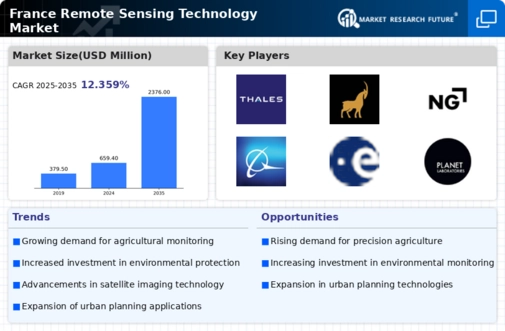Rise in Climate Change Awareness
The remote sensing-technology market is witnessing growth fueled by heightened awareness of climate change and its impacts. In France, there is a growing recognition of the need for accurate data to inform climate action strategies. Remote sensing technologies offer valuable insights into climate patterns, land use changes, and natural resource management. The French government has committed to reducing greenhouse gas emissions by 40% by 2030, which necessitates robust monitoring systems. This commitment is likely to drive investments in remote sensing technologies, as they play a crucial role in tracking progress and formulating effective climate policies.
Expansion of Smart City Initiatives
The remote sensing-technology market is benefiting from the expansion of smart city initiatives in France. Urban areas are increasingly adopting technologies that enhance infrastructure management and improve quality of life for residents. Remote sensing technologies provide critical data for urban planning, traffic management, and public safety. The French government has allocated €500 million to support smart city projects, which is expected to stimulate demand for remote sensing solutions. This investment is likely to foster innovation and collaboration among technology providers, thereby enhancing the capabilities of the remote sensing-technology market.
Growing Demand for Environmental Compliance
The remote sensing-technology market is being driven by an increasing need for environmental compliance across various sectors. In France, regulatory frameworks are becoming more stringent, necessitating accurate monitoring of environmental parameters. Industries such as agriculture and construction are required to adhere to environmental standards, which can be effectively monitored through remote sensing technologies. The market for environmental monitoring solutions is projected to grow by 15% annually, reflecting the urgency for compliance. This trend is likely to propel the adoption of remote sensing technologies, as they provide essential data for assessing environmental impacts and ensuring adherence to regulations.
Increased Investment in Defense and Security
The remote sensing-technology market is experiencing growth due to increased investment in defense and security applications. In France, the government has recognized the strategic importance of satellite imagery and remote sensing data for national security. The defense budget has seen a rise of 10% in recent years, with a portion allocated to enhancing surveillance capabilities through remote sensing technologies. This trend indicates a growing reliance on advanced technologies for intelligence gathering and border security. As a result, the remote sensing-technology market is likely to expand, driven by the demand for sophisticated monitoring solutions in the defense sector.
Technological Advancements in Satellite Systems
The remote sensing-technology market is surging due to rapid advancements in satellite technology. Innovations such as miniaturization of sensors and enhanced imaging capabilities are enabling more precise data collection. In France, the deployment of high-resolution satellites has increased, allowing for detailed monitoring of land use and environmental changes. The French government has invested approximately €1 billion in satellite technology over the past five years, which has significantly boosted the capabilities of domestic companies in this sector. This investment is likely to enhance the competitiveness of the remote sensing-technology market, as improved satellite systems can provide critical data for various applications, including agriculture, urban planning, and disaster management.

















Leave a Comment